
(a)
Interpretation:
The curved arrow mechanism for the given reaction is to be predicted.
Concept introduction:
Bronsted-Lowry bases are those species which accept proton. They are also known as proton acceptors. Base accepts a proton and forms conjugate acid. The compound
Answer to Problem 22.91AP
The curved arrow mechanism is shown below.
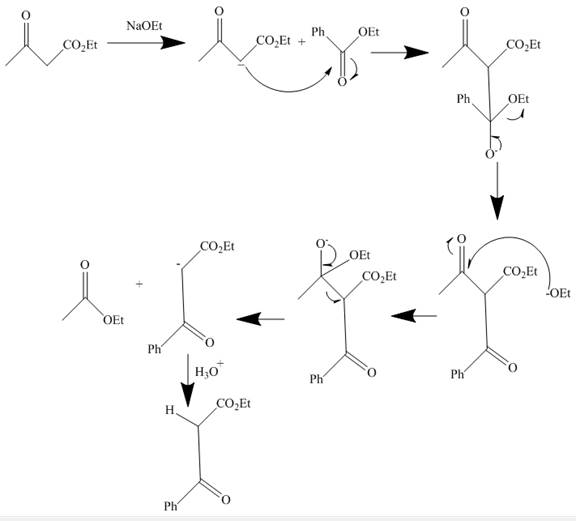
Explanation of Solution
The reaction to be completed is shown below.

Figure 1
The reaction of given ester with

Figure 2
The curved arrow mechanism is shown in Figure 2.
(b)
Interpretation:
The curved arrow mechanism for the given reaction is to be predicted.
Concept introduction:
Bronsted-Lowry bases are those species which accept proton. They are also known as proton acceptors. Base accepts a proton and forms conjugate acid. The compound
Answer to Problem 22.91AP
The curved arrow mechanism is shown below.

Explanation of Solution
The reaction to be completed is shown below.

Figure 3
The reaction of a given ester with substituted cyclic ether in the presence of a stong base undergoes ring closure with the help of internal nucleophile to form the desired product.
The complete mechanism is shown below.

Figure 4
The curved arrow mechanism is shown in Figure 4.
(c)
Interpretation:
The curved arrow mechanism for the given reaction is to be predicted.
Concept introduction:
The addition of proton in the chemical reaction is known as protonation. Water acts as a nucleophile due to the presence of lone pair on oxygen atom. Bronsted-Lowry bases are those species which accept proton. They are also known as proton acceptors. Base accepts a proton and forms conjugate acid.
Answer to Problem 22.91AP
The curved arrow mechanism is shown below.

Explanation of Solution
The reaction to be completed is shown below.

Figure 5
The reaction of given substrate with hydronium ion undergoes electrophilic addition followed by the addition of water molecule to form the desired product.
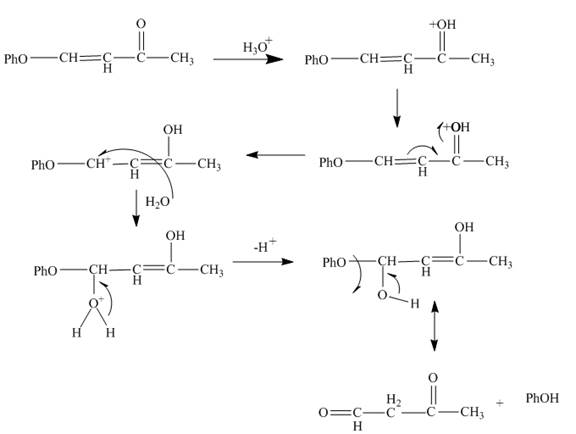
Figure 6
The curved arrow mechanism is shown in Figure 6.
(d)
Interpretation:
The curved arrow mechanism for the given reaction is to be predicted.
Concept introduction:
The addition of proton in the chemical reaction is known as protonation. Water acts as a nucleophile due to the presence of lone pair on oxygen atom. Bronsted-Lowry bases are those species which accept proton. They are also known as proton acceptors. Base accepts a proton and forms conjugate acid.
Answer to Problem 22.91AP
The curved arrow mechanism is shown below.
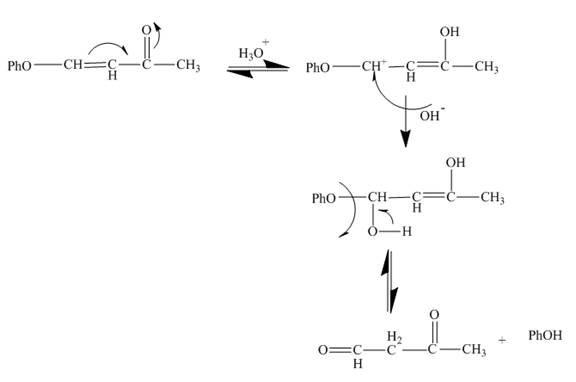
Explanation of Solution
The reaction to be completed is shown below.

Figure 7
The reaction of given substrate with

Figure 8
The curved arrow mechanism is shown in Figure 8.
(e)
Interpretation:
The curved arrow mechanism for the given reaction is to be predicted.
Concept introduction:
Nucleophilic substitution reaction is the reaction in which a nucleophile attacks the electrophilic center and a substituted product is formed. It takes place by the generation of an electrophilic intermediate.
Answer to Problem 22.91AP
The curved arrow mechanism is shown below.

Explanation of Solution
The reaction to be completed is shown below.

Figure 9
The reaction of given substrate with

Figure 10
The curved arrow mechanism is shown in Figure 10.
(f)
Interpretation:
The curved arrow mechanism for the given reaction is to be predicted.
Concept introduction:
Nucleophilic substitution reaction is the reaction in which a nucleophile attacks the electrophilic center and a substituted product is formed. It takes place by the generation of an electrophilic intermediate.
Answer to Problem 22.91AP
The curved arrow mechanism is shown below.
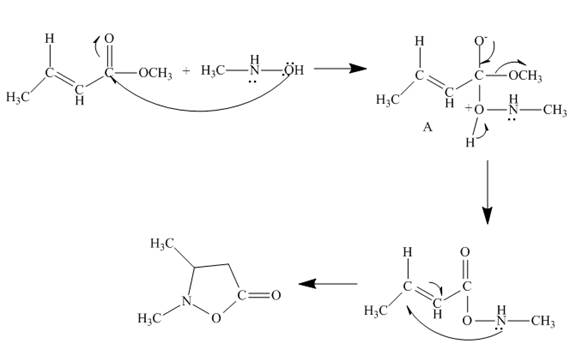
Explanation of Solution
The reaction to be completed is shown below.

Figure 11
The reaction of given ester with substituted hydroxylamine undergoes nucleophilic substitution reaction followed by ring closure with the help of lone pair present on the nitrogen atom to form the desired product. The complete mechanism is shown below.

Figure 12
The curved arrow mechanism is shown in Figure 12.
(g)
Interpretation:
The curved arrow mechanism for the given reaction is to be predicted.
Concept introduction:
Ester undergoes hydrolysis in presence of base in aqueous solution. The ester upon hydrolysis forms the carboxylate salt and alcohol. The presence of
Answer to Problem 22.91AP
The curved arrow mechanism is shown below.

Explanation of Solution
The reaction to be completed is shown below.

Figure 13
The reaction of given ester with substituted

Figure 14
The curved arrow mechanism is shown in Figure 14.
(h)
Interpretation:
The curved arrow mechanism for the given reaction is to be predicted.
Concept introduction:
Nucleophilic substitution reaction is the reaction in which a nucleophile attacks the electrophilic center and a substituted product is formed. It takes place by the generation of an electrophilic intermediate.
Answer to Problem 22.91AP
The curved arrow mechanism is shown below.
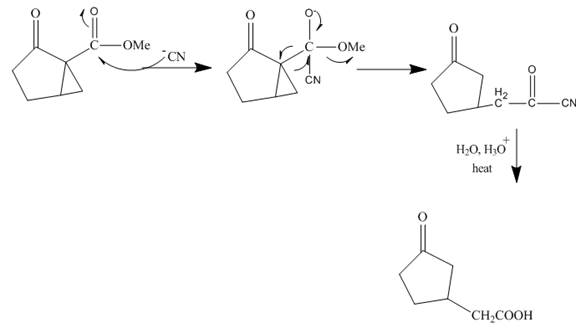
Explanation of Solution
The reaction to be completed is shown below.

Figure 15
The reaction of given ester with cyanide ion undergoes nucleophilic addition followed by hydrolysis with the removal of carbon dioxide gas to form the desired product. The complete mechanism is shown below.

Figure 16
The curved arrow mechanism is shown in Figure 16.
(i)
Interpretation:
The curved arrow mechanism for the given reaction is to be predicted.
Concept introduction:
In the Wittig reaction, an aldehydes or a
The triphenyl phophonium ylide is termed as Wittig reagent.
Answer to Problem 22.91AP
The curved arrow mechanism is shown below.
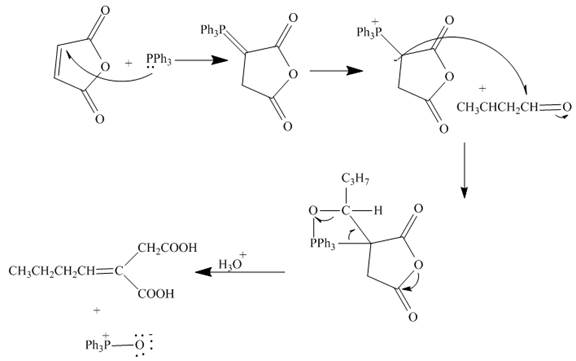
Explanation of Solution
The reaction to be completed is shown below.
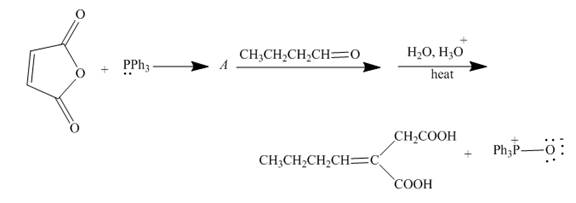
Figure 17
The reaction of given substrate with triphenyl phophine to form ylide which further reacts with carbonyl compound undergoes nucleophilic addition followed by hydrolysis gives the desired product. The complete reaction is shown below.

Figure 18
The curved arrow mechanism is shown in Figure 18.
Want to see more full solutions like this?
Chapter 22 Solutions
ORGANIC CHEMISTRY (LL)+ SAPLING ACC >BI
- Give the clear handwritten answer and give the mechanism of given bleow reactionsarrow_forwardGive a clear handwritten answer..give the mechanism with explanation needed!!!arrow_forwardGive a clear handwritten answer with explanation..give the mechanism with explanation of given bleow reaction...arrow_forward
- Give a clear handwritten answer with explanation needed!!! Give the mechanism...arrow_forwardGive a clear handwritten answer with explanation. ..give below some options choose the in which given options who react with Tollen's reagent...give textual explanation also...?arrow_forwardGive a clear handwritten answer with explanation..give the mechanism of given bleow reactions...arrow_forward
- Give a clear handwritten answer..with explanation..give the mechanism of given bleow reactionsarrow_forwardGive a clear handwritten answer with explanation..give the mechanism of given bleow reaction with detailed answer..?arrow_forwardExplain clearly Giving and example and mechanisms, explain the aromatic Substitution reactions.arrow_forward
- Give the clear handwritten answer with explanation...give the mechanism of sub parts given bleow reactions ...arrow_forwardGive a clear handwritten answer with explanation needed...give the mechanism of given bleow reactions....give answer in detailed..?arrow_forwardGive the clear handwritten answer..and give synthesis mechanism of given bleow reactions...arrow_forward
 Organic Chemistry: A Guided InquiryChemistryISBN:9780618974122Author:Andrei StraumanisPublisher:Cengage Learning
Organic Chemistry: A Guided InquiryChemistryISBN:9780618974122Author:Andrei StraumanisPublisher:Cengage Learning
